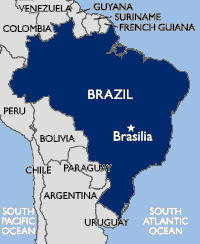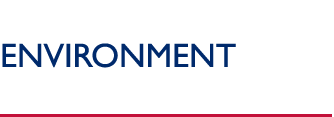Brazil
USAID has an extensive environmental program in Brazil that encompasses many imperative and current issues. Support to the Government of Brazil, as well as other interested parties, has helped Brazil address climate change through various energy and land use activities. In addition to capacity-building measures in Brazil, USAID has facilitated beneficial partnerships that help in achieving the goal of sustainable development in this extremely biodiverse country.
Background

Brazil, located in east-central South America, occupies nearly 50% of the South American continent. Slightly smaller than the United States, this Portuguese-speaking country has a total area of 3,290,000 square miles and a population of just over 190 million inhabitants.1 Brazil has traditionally been a leader in the inter-American community and as the largest economy in South America, has played an important role in collective security efforts, hemispheric economic cooperation, and international economic and trade policy discussions. Over half of Brazil is covered with forests, which include the Amazon Rainforest – the largest rainforest in the world. The country has eight river systems that carry approximately 20% of the world’s fresh water2 and is home to the continent’s largest wetland in the Pantanal region.
The USAID program in Brazil addresses regional and global issues of mutual concern, as well as its serious national-level socioeconomic problems, and includes:
- Protection of Brazil’s environment and unique biodiversity;
- Reduction of greenhouse gas emissions through the promotion of alternative energy and energy efficiency;
- Increased training and employment opportunities for disadvantaged Brazilian youth and the elimination of trafficking in youth;
- HIV/AIDS prevention and decreased tuberculosis and other communicable diseases; and
- Promotion of free trade, development of small and medium enterprises, as well as support of the Government of Brazil’s Zero Hunger Program.
USAID support to the Government of Brazil, as well as Brazilian nongovernmental organizations (NGOs) – such as the Brazilian Network of Civil Organizations for Renewable Energy and the Brazilian Forest Stewardship Council – has helped Brazil address climate change through various energy and land use activities.
Sector-Specific Climate Change Activities
USAID/Brazil’s environment and energy programs address two important environmental priorities – global climate change and conserving biological diversity. USAID activities promote sound land use in the Amazon and the Atlantic Forest. USAID efforts in this area are also increasingly focused on local community-based management plans that protect biodiversity, while providing a sustainable source of income for surrounding communities. On the energy side, USAID programs seek to support Brazil’s ability to mitigate climate change by promoting clean energy technologies and focusing on policy, regulation, and financing mechanisms critical to ensuring sustainable energy use.
Land Use and Protected Area Management
USAID/Brazil’s actions support protection and sustainable use of the natural resources base in key Brazilian ecosystems, including the Amazon, Atlantic Forest, and Cerrado/Pantanal regions.
In 2007, through the primary implementers – Institute of Environmental Research for Amazônia (IPAM), the International Institute for Education of Brazil (IEB), the World Wildlife Fund (WWF/Brazil), and many collaborating agencies – USAID supported the elaboration of community forest management plans, markets for forest products, educational outreach on climate change issues, and designing and evaluating project opportunities under the carbon market.
In 2007, with USAID support, partners worked on the elaboration and approval of community forest management plans covering an area of 3,403,000 hectares (ha). By including community members in collective decision-making, local level conservation initiatives are more likely to be sustainable and enforceable.
Three major sustainable management plans involving multiple stakeholders were also elaborated, including: reforestation of Xingu headwaters (45,000 ha); a regional plan for the development of BR-318 Highway (1,000,000 ha); and the Sustainable Development Plan for the Transamazon Territory (PTDRS, 24,361,000 ha). Sustainable management plans are essential in minimizing the risks to high value biological corridors threatened by development initiatives.
In the area of outreach, USAID has allocated resources to update the booklet “Questions and Answers about Climate Change” and has been preparing to publish the book “Tropical Deforestation and Climate Change.” These educational pieces are intended to teach populations about the challenges of climate change and stimulate demand for proactive solutions to halt its progression.
In the Indigenous Territories, USAID and its partners are providing technical assistance to communities in conservation management and economic growth activities from sustainable forest management. For example, two Indigenous Reserves have been trained to produce “copaiba” oil, resulting in revenue of near US$10,000. The community forest management associations, Cooperfloresta and GPFC (Group of Forest Community Producers), have been trained in both forest management and administrative skills, resulting in revenue of nearly US$66,000 for 33 families.
Partner organizations (Pesacre, IPE and Imazon) have directly assisted in the participatory planning for conservation and sustainable use of 75,003 km2 (7,500,300 ha) of forests in the Amazon and Mata Atlantica forest regions. This was accomplished by training small farmers to implement small scale management plans; mapping vulnerability zones of the Atlantic Forest and presenting them to public authorities; and developing models of timber exploitation and fire risks for the Amazon region (Imazon). Furthermore, partners have directly assisted the certification of 15,528 km2 (1,552,800 ha) of land to support the bidding process of the first forest concession (“Jamari” National Forest – 2,200 km2) in the Amazon region. The bidding is to be conducted by the newly created Brazilian Forest Service.
USAID-supported training and capacity-building has helped reduce the gap between the demand for qualified technicians, foresters, government auditors and decision-makers and the supply of qualified forest management professionals in Amazonia. In 2007, USAID partners trained 2,180 technicians in sound forest management techniques.
Despite drops in deforestation rates from 2004 to 2006, figures for the second half of 2007 showed a rapid increase in deforestation. As a result, deforestation rates for the 2007/2008 period may rise to at least 22% of the previous period. The major deforestation rates were observed in the States of Mato Grosso and Pará, where the main economic growth activities are soy planting and cattle ranching.
USAID/Brazil has continued to show enduring progress toward helping to halt deforestation and environmental degradation of the Amazonian rainforest, both major causes of Brazil’s contribution to carbon dioxide (CO2) emissions.
Energy Sector
In 2007, USAID supported two major energy projects in Brazil focused mainly on developing local renewable energy capacity and training public and private sector organizations on how to improve energy efficiency practices.
The Energia & Desenvolvimento (E&D) is a consortium of five nongovernmental organization (NGO) partners that are working on developing local renewable energy capacity, fostering the use of clean energy technologies and services, and assisting the Government of Brazil to put in place policies to develop a market for clean and efficient energy.
The consortium has proven very successful at transforming training into action. As a result, they organized 48 workshops, benefiting 943 individuals who learned about the importance of environmental protection and sustainable energy concepts. Farmers were trained to operate biodigestors for biogas and electricity, cook and dry food produce, and use biofertilizer for productive chains ranging from organic agriculture to dairy farming. Beneficiaries were also trained in how to properly dispose of animal waste, avoiding contamination of goat and cattle livestock with water-borne disease. Results showed that 401 families have adopted environmentally-friendly practices and biofertilization techniques in their crops. The program also substituted diesel-fired generators with small hydro power plants in rural areas and trained local residents to operate and maintain the system. USAID/Brazil work on small hydro power plants, as well as methane recovery in a landfill in Fortaleza, has resulted in the avoidance of an estimated 4,300,000 tons of CO2.
With respect to livelihoods, trainees learned how to operate solar driers to dry their products – ranging from fruits, spices, and seaweed – which, in the end, added more value to the final selling price. A group of 20 at-risk youth ranging from 16 to 24 years received a five-month training course to raise their awareness about climate change issues and prepare them for job-market opportunities in the energy industry. Post training assessments indicate that 70% of trainees are working, or pursuing college studies.
In previous years, USAID has played a major role in the energy policy arena and in outreach initiatives. USAID/Brazil’s energy program contributions in the policy arena resulted in new legislation restructuring the energy sector (Law 10438) as well as the PROINFA Program to increase the participation of alternative energy sources in the Brazilian energy matrix. In 2004, USAID cosponsored Brazil’s largest renewable energy trade fair ever, “Power Future 2004,” which brought together over 2,000 participants and 40 local and international exhibitors, including five U.S. corporations. USAID estimates that the event resulted in direct sales, service contracts, and business partnership proposals valued as high as US$30 million.
Through the Global Village Energy Partnership (GVEP) – a 10-year sustainable development partnership – USAID/Brazil supports the provision of energy to the underserved as a means to accelerate rural development and alleviate poverty. In 2005 and 2006, USAID/Brazil pilot tested the GVEP Action Plan in six communities that used their newly acquired energy to develop productive income-generating activities, benefiting over 6,000 people.
The Brazil Energy Capacity Building Program (BECBP) promotes energy efficiency and renewable energy use in Brazil through training and capacity-building activities, benefiting public and private sector organizations. Over the course of four years, the project has included training sessions for the Brazilian government, private sector, and other NGO stakeholders; international executive exchange programs; invitational travel for training experts; and the implementation of online information technology systems to disseminate the impact of results and make capacity-building information available to a wider audience. In 2007, BECBP provided on-site workshops for 248 people and online training to 441 individuals from the government, private-public sector and universities who were keen to learn more about energy efficiency methods and approaches to diminish operational costs, benefit the environment and promote “green” marketing with energy savings. A group of 30 people was also trained in efficient public lighting and municipal energy management in order to promote municipal-level policies, regulations, and actions to enhance the efficiency of municipal energy use in illumination. Another 131 individuals from the commercial sector and 58 individuals from the industrial sector were trained in energy efficiency practices. Brazilian industries are extremely concerned about maintaining their competitiveness in the global market, and these courses addressed new approaches and introduced tactics to improve energy operations for better energy efficiency practices. The Program’s essential partner in this activity was the National Program for Energy Conservation (PROCEL). Now that the BECBP has completed its last year of activities, PROCEL is willing to continue delivering courses in energy efficiency by adopting the same methodology and approach. This partnership was possibly the most successful outcome of the Program and has undoubtedly contributed to its future sustainability.
Finally, under the Energia Productiva Project, USAID supported a consortium of eight NGO partners, which promoted the use of sustainable and clean energy technologies in North and Northeast Brazil. Training initiatives and information dissemination reached more than 60,000 beneficiaries, while direct income-generating and improved quality-of-life interventions reached over 8,000 people.
Partners
USAID’s partners in climate change activities in Brazil include:
- Amazon Institute for Man and the Environment (IMAZON)
- Amazon Workers Center (CTA)
- Brazilian Forest Stewardship Council (FSC)
- Brazilian Government agencies including Brazilian Environment Agency (IBAMA), Brazilian Ministry of the Environment (MMA), and Brazilian Ministry of Mines and Energy (MME)
- Brazilian Network of Civil Organizations for Renewable Energy (RENOVE)
- ICF Consulting
- Institute of Ecological Research (IPE)
- Institute of Environment Research for Amazônia (IPAM)
- Institute of Forestry and Agricultural Management and Certification (IMAFLORA)
- Instituto de Desenvolvimento Sustentavel e Energias Renovaveis (IDER)
- Instituto Floresta Tropical (IFT)
- International Institute of Education of Brazil (IIEB)
- “Kaninde” Association of Ethno-Environmental Defense
- The Nature Conservancy (TNC)
- Woods Hole Research Center (WHRC)
- World Bank/Global Environment Facility (GEF)
- World Wildlife Fund (WWF)
Because partners change as new activities arise, this list of partners is not comprehensive.
Back to Top ^
|


